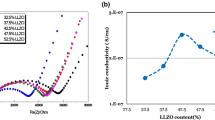Abstract
Organic-inorganic hybrid lithium ion conductors were prepared by the sol-gel process. The hybrid ion conductor will be used as the electrolyte for Li based high-energy density batteries. The hybrid ion conductor was prepared from a mixture of tetramethyl orthosilicate (TMOS), polyethylene glycol 200 (PEG200), lithium perchlorate (LiClO4) and water. A wet gel was prepared at room temperature. The gels dried at 80°C under vacuum did not contain water. The dried hybrid ion conductor gel had homogeneity and high transparency. Ionic conductivity of the hybrid sample was measured by the complex impedance method and it increased with increasing PEG200 content. The dried hybrid gel that contained no LiClO4 did not show ion conduction. Conductivity on the order of 10−5 S·cm−1 at room temperature was obtained. Structural characterization was done by Fourier Transform Infrared Spectra (FTIR) and NMR measurement of 13C and 1H, and the thermal stability and glass transition properties were studied by DSC. Glass transition temperature decreased with increasing PEG200 content and increased with increasing [Li]/[O] ratio (the oxygen considered is from the polyethylene glycol). Existence of the Si–O–(C2H4O) n –bond and the C–OH bond in the framework of the organic and inorganic phases was confirmed. TMOS and PEG200 were hydrolyzed and condensed. The organic and inorganic phases were chemically bonded and the microstructure of the hybrid matrix was shaped as comb. The comb shape leads to high ionic conduction.
Similar content being viewed by others
References
T. Oosaka, Key Technology Denchi (Maruzen, Tokyo, 1996) (in Japanese).
M. Watanabe, S. Nagano, K. Sanui, and N. Ogata, J. Power Sources 20, 327 (1987).
S. Panero, B. Scrosati, and S.G. Greenbaum, Electrochimica Acta 37(9), 1533 (1992).
C.H. Kim and J.K. Park, Solid State Ionic 116, 53 (1999).
D.E. Fenton, J.M. Parker, and P.V. Wright, Polymer 14, 589 (1973).
M.B. Armand, J.M. Chabagno, and M.J. Duclo, Fast Ion Transport in Solids (North-Holland, 1979).
N. Yamada, I Yoshinaga, and S. Katayama, New Ceramics 8, 23 (1997) (in Japanese).
H. Sakaguchi, Sekigaikyukouzusetusouran (Sankyosyuppan, 1977) (in Japanese).
T. Nakanishi, P.H. Solomon, and N. Furutachi, Sekigaikyusyu Spectrum (Nankoudou, 1978) (in Japanese).
T. Nakanishi et al., Yuuki kagoubutu spectrum deta (Koudansya, 1993) (in Japanese).
P. Judeinstein, J. Titman, M. Stamm, and H. Schmidt, Chem. Mater. 6, 127 (1994).
W. Kemp and A. Yamasaki, NMR in Chemistry: A Multinuclear Introduction (Baihukan, 1998) (in Japanese).
Author information
Authors and Affiliations
Rights and permissions
About this article
Cite this article
Nishio, K., Okubo, K., Watanabe, Y. et al. Structural Analysis and Properties of Organic-Inorganic Hybrid Ionic Conductor Prepared by Sol-Gel Process. Journal of Sol-Gel Science and Technology 19, 187–191 (2000). https://doi.org/10.1023/A:1008771818533
Issue Date:
DOI: https://doi.org/10.1023/A:1008771818533




